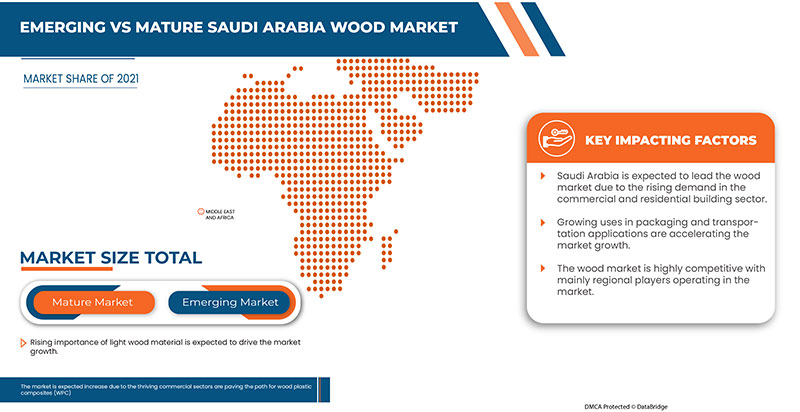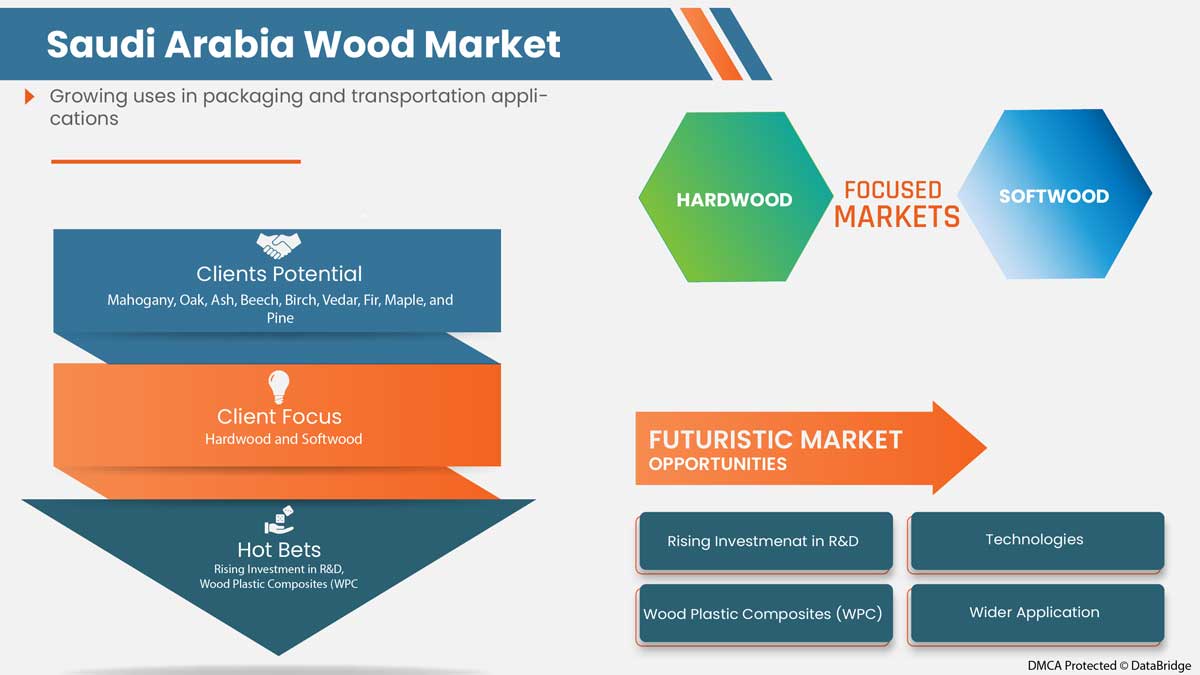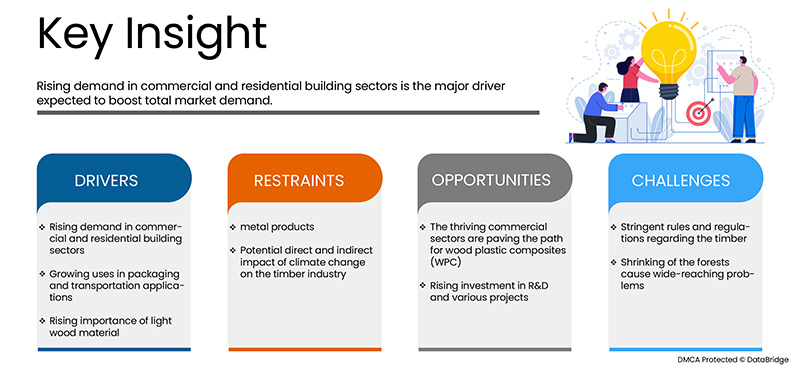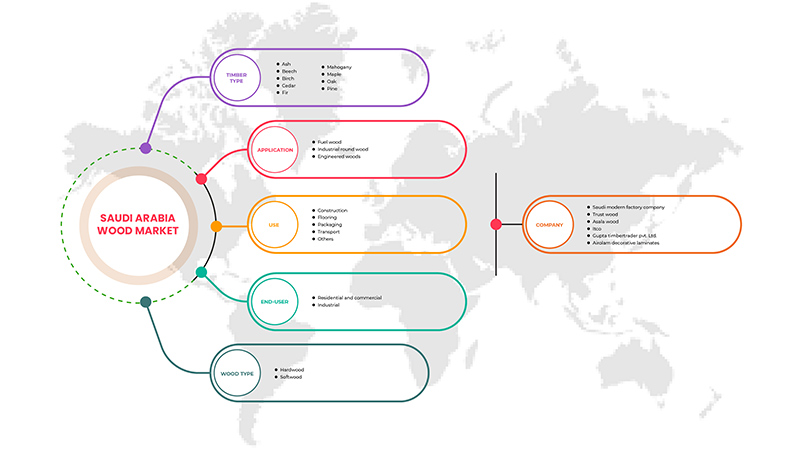Saudi Arabia Wood Market Analysis and Size
Rising commercial and residential building demand is an important driver for the Saudi Arabia wood market. In addition, the growing uses in packaging and transportation applications are accelerating market growth.


Data Bridge Market Research analyses that the Saudi Arabia wood market is expected to reach the value of USD 4,101.80 million by the year 2029, at a CAGR of 2.2% during the forecast period. Mahogany Accounts for the most prominent timber type segment.
|
Report Metric |
Details |
|
Forecast Period |
2022 to 2029 |
|
Base Year |
2021 |
|
Historic Years |
2020 (Customizable to 2019 - 2014) |
|
Quantitative Units |
Revenue in USD Million |
|
Segments Covered |
By Timber Type (Ash, Beech, Birch, Cedar, Fir, Mahogany, Maple, Oak, and Pine), Application (Fuel Wood, Industrial Round Wood, and Engineered Woods), Use (Construction, Flooring, Packaging, Transport, and others), End-User (Residential and commercial, and Industrial), Wood Type (Hardwood, and Softwood). |
|
Countries Covered |
Saudi Arabia |
|
Market Players Covered |
Saudi Modern Factory Company, Trust Wood, Asala Wood, ITCO, Gupta Timbertrader Pvt. Ltd., and Airolam decorative laminates. |
Market Definition
The wood industry is the industry concerned with forestry, logging, timber trade, and the production of primary forest products and wood products (for instance furniture) and secondary products such as wood pulp for the pulp and paper industry. Some of the largest producers are also among the biggest owners of timberland. The wood industry has historically been and continues to be an important sector in many economies. Wood is relatively light in weight and strong because wood's efficiency for structural purposes has qualities similar to steel. Wood is usually classified as either hardwood from broad-leafed trees, such as Beech and Oak, or softwood from conifers such as Pine and Fir. Because they're replaceable, fast-growing species like Pine trees tend to be more sustainable than slow-growing trees like Oak. Oak forests must be managed carefully to make them sustainable, grown, and harvested correctly, but it can be done.
Engineered wood is generally made from the same hardwoods and softwoods used to manufacture lumber but mixed with additives like adhesives. This type of wood often utilizes waste wood from sawmills and are treated through chemical or heat processes to produce wood that meets size requirements that are hard to find in nature. Engineered wood is used in various applications, from home construction to commercial buildings to industrial products. Saudi Arabia has introduced legal measures to protect its woodlands and forests, and these days more trees are planted than felled. It's great news for the future, with Saudi Arabia's forests actually growing instead of diminishing.
The Market Dynamics of the Saudi Arabia Wood Market Include:
Drivers
- Rising demand in commercial and residential building sectors
Wood and timber are currently commonly utilized in building materials and are quickly replacing concrete and steel as the material of choice due to their lower carbon footprint. Currently, the building sector accounts for 25% of Saudi Arabia's greenhouse gas emissions, and the industry thinks that green building construction may assist cut CO2 emissions and storing carbon. Wood is proven to have the requisite resilience, hardness, durability, and strength while delivering distinct advantages over steel and concrete in commercial, residential, and industrial structures. Timber allows architects and builders to create sustainable, economical, and ecologically friendly structures. For more ambitious projects, wood and lumber are used as building materials. It is a costly material for building construction, and furniture manufactures, such as doors, windows, cabinets, cupboards, shelves, tables, and many others. Timber is also extensively used as plywood (Plywood blocks and plywood boards) and raw wood. Heavy patterned doors and windows are composed of solid wood/timber for strength, toughness, and longevity. As a result of these characteristics and applications, Timber and wood have become major building materials.
- Growing uses in packaging and transportation applications
Wood and timber play an important part in packing and shipping. Wooden packaging has been utilized since ancient times for its great strength and inexpensive cost... In the past, few other materials surpassed wood in terms of packing. However, rising awareness of sustainable growth and environmental preservation aided in reintroducing wood as the primary packaging material. Compared to other materials, the wooden packaging is said to be more stable and ecologically friendly. These materials are long-lasting, renewable, environmentally benign, suitable for heavy objects, and stackable. Wooden packaging material is best suited for sectors dealing with heavy-weight items. It is regarded as the most cost-effective packaging solution due to its great strength and cheap cost.
- Rising importance of light wood material
As sustainable timber, light wood is a potential alternative for building homes, decorations, furniture, exterior design, and products such as paper, picture frames, shelves, cabinets, wardrobes, garden fences, planter boxes, and others. Its key benefit over hardwood is its lightweight and low density. Similarly, light wood species may develop quickly while producing high-quality timber. Lightwood has the potential to be a game changer in the building sector. Because these species grow quickly, one can obtain quickly, high-quality, and sustainable wood and other wood products. As a high-quality timber building material, light wood may give a strategic advantage as a timber business and has a distinctive standing in technical wood goods and modern mass timber construction. Using wood to its full potential allows one to enhance the impact of climate advantages such as CO2 sequestration (forest carbon stock), CO2 storage (carbon in materials), the substitution of high-emission products, and recycling (end of life cycle).

Opportunities
- The thriving commercial sectors are paving the path for wood plastic composites (WPC)
In recent years, Saudi Arabia has seen tremendous expansion in commercial areas such as offices, retail, industrial, healthcare, leisure, and others. To begin with, utilizing actual wood necessitates the removal of trees, which play a critical role in lowering CO2 emissions. Wood is also heavier than plastic, so delivering and transporting genuine wood is more expensive, requiring more fuel and leaving a larger carbon impact. Despite its numerous benefits, it has some detrimental environmental consequences. As people became more concerned about the environment and realized the worth of trees, they began to prefer alternatives to wood. This is where wood plastic composite (WPC) comes in, an excellent replacement for wood with similar qualities and strong environmental advantages.
- Rising investment in R&D and various projects
Saudi Arabia is investing in R&D to diversify its economy. The research, development, and innovation sector aim to boost the kingdom's competitiveness. The RDI plans rely significantly on open innovation and science, including establishing special programs through the center for special residents that will draw experts from across the world and make migration to the kingdom simple. Changes in the Kingdom's long-term plans are driving the Saudi economy, particularly with a growing population that is more accustomed to a digitalized economy. The most crucial is the forward-thinking atmosphere provided by Saudi Vision 2030, a strategy framework initially announced in 2016 to reduce the country's reliance on oil earnings by growing domestic consumption and supporting private-sector development. The government is committed to diversifying its revenue sources away from oil. As a result, it aids in the transition away from plastics and toward wood and timber material items.
Restraints/Challenges
- Availability of substitutes such as plastics and metal products
Engineers have long used wood, metal, and concrete to construct numerous constructions. Timber walks were employed in forest preserves, and park authorities frequently acquired metal seating. Wood was also employed by manufacturers for cribbing. Engineers developed recycled plastic lumber, which is more environmentally friendly, more durable, and less expensive than wood. Although metal, concrete, and wood have several advantages, many people are moving away from wood in a variety of building projects in order to aid the earth's earth and preserve our natural resources. Steel construction is out of reach for clients on a limited budget due to the high costs of manufacture, shipment, and installation. While concrete is a long-lasting and low-maintenance material, there are alternative materials on the market, such as plastic lumber, that fit the bill and the project better. Metal (expense, fire danger, corrosion), concrete (time, contraction), and lumber all have drawbacks (shrinking, swelling, deterioration, health hazard).
- Potential direct and indirect impact of climate change on the timber industry
Forest wood has been a vital necessity for humanity since the dawn of civilization and remains the primary supply for many applications in our daily lives. Trees serve to sustain the water cycle and provide habitat for species. The Saudi Arabia’s impact of both direct and indirect climate change has hampered the expansion of wood production. The largest loss of forest related to climate is forest fire, which kills many trees each year. This is caused by severe summer and winter temperatures. Nature sparked the fire, which resulted in a massive loss of forest cover.
- Stringent rules and regulations regarding the timber
Saudi Arabia's forests are threatened by a harsh environment characterized by low fluctuating rainfall, severe drought, high temperatures, and human effects such as urban and agricultural development, as well as fuel wood harvesting. A scarcity of competent forestry professionals in comparison to what is necessary to carry out the activities required to sustainably manage the resources exacerbates the mix of natural and manmade causes. In response to these causes, the Saudi government has undertaken and/or supported a number of institutional and/or legislative efforts, as well as a number of programs, to reduce forest degradation and maintain, extend, and develop existing forests.
- Shrinking of the forests causes wide-reaching problems
Deforestation entails chopping down trees to a considerable amount, whether they are forests, barren ground, or trees one passes on their walk to school every day. Natural forests are being destroyed to cultivate the land, create houses and industries, log, clear land for livestock grazing, extract oil, mine, build dams, or acquire wood for furniture and fuel. The loss of forest cover impacts biodiversity, which in turn threatens people's lives. Forest shrinkage causes widespread issues such as soil erosion, less crops, floods, water cycle disturbance, greenhouse gas emissions, climate changes, and biodiversity loss.
For Instance,
- In 2021, according to Timber Exchange due to increasing demand in Riyadh, Jeddah, Dammam, and Khobar, Saudi Arabia requires one million additional houses over the next ten years. The demand will create 628,000 units, with Riyadh accounting for 48 percent of the units.
Saudi Arabia Wood Market Scope
The Saudi Arabia wood market is segmented on the basis of timber type, application, use, end-user, and wood type. The growth amongst these segments will help you analyze meagre growth segments in the industries and provide the users with a valuable market overview and market insights to help them make strategic decisions for identifying core market applications.
By Timber Type
- Ash
- Beech
- Birch
- Cedar
- Fir
- Mahogany
- Maple
- Oak
- Pine
On the basis of timber type, Saudi Arabia wood market is classified into ash, beech, birch, cedar, fir, mahogany, maple, oak, and pine.
Application
- Fuel Wood
- Industrial Round Wood
- Engineered Woods
On the basis of application, Saudi Arabia wood market is classified into fuel wood, industrial round wood, and engineered woods.
Use
- Construction
- Flooring
- Packaging
- Transport
- Others
On the basis of use, Saudi Arabia wood market is classified into construction, flooring, packaging, transport, and others.
End Use
- Residential and commercial
- Industrial

On the basis of end-use, Saudi Arabia wood market is classified into residential and commercial, and industrial.
Wood Type
- Hardwood
- Softwood
On the basis of wood type, Saudi Arabia wood market is classified into hardwood, and softwood.
Competitive Landscape and Saudi Arabia Wood Share Analysis
The Saudi Arabia wood market competitive landscape provides details by competitor. Details included are company overview, company financials, revenue generated, market potential, investment in research and development, new market initiatives, Saudi Arabia presence, production sites and facilities, production capacities, company strengths and weaknesses, product launch, product width and breadth, application dominance. The above data points provided are only related to the companies' focus related to Saudi Arabia wood market.
Some of the major market players engaged in the Saudi Arabia wood market are Saudi Modern Factory Company, Trust Wood, Asala Wood, ITCO, Gupta Timbertrader Pvt. Ltd., and Airolam decorative laminates.
SKU-
Get online access to the report on the World's First Market Intelligence Cloud
- Interactive Data Analysis Dashboard
- Company Analysis Dashboard for high growth potential opportunities
- Research Analyst Access for customization & queries
- Competitor Analysis with Interactive dashboard
- Latest News, Updates & Trend analysis
- Harness the Power of Benchmark Analysis for Comprehensive Competitor Tracking
Table of Content
1 INTRODUCTION
1.1 OBJECTIVES OF THE STUDY
1.2 MARKET DEFINITION
1.3 OVERVIEW OF SAUDI ARABIA WOOD MARKET
1.4 LIMITATION
1.5 MARKETS COVERED
2 MARKET SEGMENTATION
2.1 MARKETS COVERED
2.2 GEOGRAPHICAL SCOPE
2.3 YEARS CONSIDERED FOR THE STUDY
2.4 CURRENCY AND PRICING
2.5 DBMR TRIPOD DATA VALIDATION MODEL
2.6 WOOD TYPE LINE CURVE
2.7 MULTIVARIATE MODELING
2.8 PRIMARY INTERVIEWS WITH KEY OPINION LEADERS
2.9 DBMR MARKET POSITION GRID
2.1 MARKET APPLICATION COVERAGE GRID
2.11 DBMR MARKET CHALLENGE MATRIX
2.12 DBMR VENDOR SHARE ANALYSIS
2.13 IMPORT-EXPORT DATA
2.14 SECONDARY SOURCES
2.15 ASSUMPTIONS
3 EXECUTIVE SUMMARY
4 PREMIUM INSIGHTS
4.1 SAUDI ARABIA WOOD AND TIMBER MARKET, PESTEL ANALYSIS
4.1.1 OVERVIEW
4.1.2 POLITICAL FACTORS
4.1.3 ENVIRONMENTAL FACTORS
4.1.4 SOCIAL FACTORS
4.1.5 TECHNOLOGICAL FACTORS
4.1.6 ECONOMICAL FACTORS
4.1.7 LEGAL FACTORS
4.1.8 CONCLUSION
4.2 ILLEGAL WOOD IMPORTS FROM INDONESIA
4.3 CERTIFICATION
4.4 COMPLETE LIFE CYCLE OF WOOD AND TIMBER
4.5 LEGAL AND ILLEGAL IMPORT OF WOOD AND TIMBER INTO SAUDI ARABIA MARKET
4.6 SUSTAINABILITY FOR WOOD AND TIMBER
4.7 SUSTAINABILITY OF WOOD
4.8 TRANSPORT AND CUSTOM DETAILS OF TIMBER AND WOOD
4.9 REGULATION AND STANDARDS FOR WOOD AND TIMBER
5 MARKET OVERVIEW
5.1 DRIVERS
5.1.1 RISING DEMAND IN COMMERCIAL AND RESIDENTIAL BUILDING SECTORS
5.1.2 GROWING USES IN PACKAGING AND TRANSPORTATION APPLICATIONS
5.1.3 RISING IMPORTANCE OF LIGHT WOOD MATERIAL
5.2 RESTRAINTS
5.2.1 AVAILABILITY OF SUBSTITUTES SUCH AS PLASTICS AND METAL PRODUCTS
5.2.2 POTENTIAL DIRECT AND INDIRECT IMPACT OF CLIMATE CHANGE ON THE TIMBER INDUSTRY
5.3 OPPORTUNITIES
5.3.1 THE THRIVING COMMERCIAL SECTORS ARE PAVING THE PATH FOR WOOD PLASTIC COMPOSITES (WPC)
5.3.2 RISING INVESTMENT IN R&D AND VARIOUS PROJECTS
5.4 CHALLENGES
5.4.1 STRINGENT RULES AND REGULATIONS REGARDING THE TIMBER
5.4.2 SHRINKING OF THE FORESTS CAUSES WIDE-REACHING PROBLEMS
6 SAUDI ARABIA WOOD MARKET, BY TIMBER TYPE
6.1 OVERVIEW
6.2 MAHOGANY
6.3 OAK
6.4 ASH
6.5 BEECH
6.6 BIRCH
6.7 CEDAR
6.8 FIR
6.9 MAPLE
6.1 PINE
7 SAUDI ARABIA WOOD MARKET, BY APPLICATION
7.1 OVERVIEW
7.2 INDUSTRIAL ROUND WOOD
7.3 ENGINEERED WOODS
7.3.1 CROSS-LAMINATED TIMBER (CLT)
7.3.2 ORIENTED STRAND BOARDS (OSB)
7.3.3 GLULAM (GLUED LAMINATED TIMBER)
7.3.4 LAMINATED VENEER LUMBER (LVL)
7.3.5 I-BEAMS, PLYWOOD
7.3.6 OTHERS
7.4 FUEL WOOD
8 SAUDI ARABIA WOOD MARKET, BY USE
8.1 OVERVIEW
8.2 CONSTRUCTION
8.3 FLOORING
8.4 PACKAGING
8.5 TRANSPORT
8.6 OTHERS
9 SAUDI ARABIA WOOD MARKET, BY END USER
9.1 OVERVIEW
9.2 RESIDENTIAL AND COMMERCIAL
9.3 INDUSTRIAL
10 SAUDI ARABIA WOOD MARKET, BY WOOD TYPE
10.1 OVERVIEW
10.2 HARDWOOD
10.3 SOFTWOOD
11 SAUDI ARABIA WOOD MARKET, COMPANY LANDSCAPE
11.1 COMPANY SHARE ANALYSIS: SAUDI ARABIA
11.2 CERTIFICATION
12 SWOT ANALYSIS
13 COMPANY PROFILES
13.1 ITCO
13.1.1 COMPANY SNAPSHOT
13.1.2 PRODUCT PORTFOLIO
13.1.3 RECENT DEVELOPMENT
13.2 GUPTA TIMBERTRADER PVT. LTD.
13.2.1 COMPANY SNAPSHOT
13.2.2 PRODUCT PORTFOLIO
13.2.3 RECENT DEVELOPMENT
13.3 ASALA WOOD
13.3.1 COMPANY SNAPSHOT
13.3.2 PRODUCT PORTFOLIO
13.3.3 RECENT DEVELOPMENT
13.4 SAUDI MODERN FACTORY COMPANY
13.4.1 COMPANY SNAPSHOT
13.4.2 PRODUCT PORTFOLIO
13.4.3 RECENT DEVELOPMENT
13.5 TRUST WOOD
13.5.1 COMPANY SNAPSHOT
13.5.2 PRODUCT PORTFOLIO
13.5.3 RECENT DEVELOPMENT
13.6 AIROLAM DECORATIVE LAMINATES
13.6.1 COMPANY SNAPSHOT
13.6.2 REVENUE ANALYSIS
13.6.3 PRODUCT PORTFOLIO
13.6.4 RECENT DEVELOPMENT
14 QUESTIONNAIRE
15 RELATED REPORTS
List of Table
TABLE 1 IMPORT DATA OF BITUMEN AND WOOD, NATURAL; BITUMINOUS OR OIL-SHALE AND TAR SANDS; WOODITES AND WOODIC; HS CODE – 2714 (USD MILLION)
TABLE 2 EXPORT DATA OF BITUMEN AND WOOD, NATURAL; BITUMINOUS OR OIL-SHALE AND TAR SANDS; WOODITES AND WOODIC; HS CODE – 2714 (USD MILLION)
TABLE 3 SAUDI ARABIA WOOD MARKET, BY TIMBER TYPE, 2020-2029 (USD MILLION)
TABLE 4 SAUDI ARABIA WOOD MARKET, BY APPLICATION, 2020-2029 (USD MILLION)
TABLE 5 SAUDI ARABIA ENGINEERED WOODS IN WOOD MARKET, BY TYPE, 2020-2029 (USD MILLION)
TABLE 6 SAUDI ARABIA WOOD MARKET, BY USE, 2020-2029 (USD MILLION)
TABLE 7 SAUDI ARABIA WOOD MARKET, BY END USER, 2020-2029 (USD MILLION)
TABLE 8 SAUDI ARABIA WOOD MARKET, BY WOOD TYPE, 2020-2029 (USD MILLION)
List of Figure
FIGURE 1 SAUDI ARABIA WOOD MARKET: SEGMENTATION
FIGURE 2 SAUDI ARABIA WOOD MARKET: DATA TRIANGULATION
FIGURE 3 SAUDI ARABIA WOOD MARKET: DROC ANALYSIS
FIGURE 4 SAUDI ARABIA WOOD MARKET: SAUDI ARABIA MARKET ANALYSIS
FIGURE 5 SAUDI ARABIA WOOD MARKET: COMPANY RESEARCH ANALYSIS
FIGURE 6 SAUDI ARABIA WOOD MARKET: THE WOOD TYPE LIFE LINE CURVE
FIGURE 7 SAUDI ARABIA WOOD MARKET: MULTIVARIATE MODELLING
FIGURE 8 SAUDI ARABIA WOOD MARKET: INTERVIEW DEMOGRAPHICS
FIGURE 9 SAUDI ARABIA WOOD MARKET: DBMR MARKET POSITION GRID
FIGURE 10 SAUDI ARABIA WOOD MARKET: MARKET APPLICATION COVERAGE GRID
FIGURE 11 SAUDI ARABIA WOOD MARKET: THE MARKET CHALLENGE MATRIX
FIGURE 12 SAUDI ARABIA WOOD MARKET: VENDOR SHARE ANALYSIS
FIGURE 13 SAUDI ARABIA WOOD MARKET: SEGMENTATION
FIGURE 14 RISING DEMAND IN COMMERCIAL AND RESIDENTIAL BUILDING SECTORS IS EXPECTED TO DRIVE SAUDI ARABIA WOOD MARKET IN THE FORECAST PERIOD
FIGURE 15 INDUSTRIAL ROUND WOOD SEGMENT IS EXPECTED TO ACCOUNT FOR THE LARGEST SHARE OF THE SAUDI ARABIA WOOD MARKET IN 2022 & 2029
FIGURE 16 SAUDI ARABIA WOOD AND TIMBER MARKET: PESTEL ANALYSIS
FIGURE 17 DRIVERS, RESTRAINTS, OPPORTUNITIES AND CHALLENGES OF SAUDI ARABIA WOOD MARKET
FIGURE 18 SAUDI ARABIA WOOD MARKET: BY TIMBER TYPE, 2021
FIGURE 19 SAUDI ARABIA WOOD MARKET: BY APPLICATION, 2021
FIGURE 20 SAUDI ARABIA WOOD MARKET: BY USE, 2021
FIGURE 21 SAUDI ARABIA WOOD MARKET: BY END USER, 2021
FIGURE 22 SAUDI ARABIA WOOD MARKET: BY WOOD TYPE, 2021
FIGURE 23 SAUDI ARABIA WOOD MARKET: COMPANY SHARE 2021 (%)

Saudi Arabia Wood Market, Supply Chain Analysis and Ecosystem Framework
To support market growth and help clients navigate the impact of geopolitical shifts, DBMR has integrated in-depth supply chain analysis into its Saudi Arabia Wood Market research reports. This addition empowers clients to respond effectively to global changes affecting their industries. The supply chain analysis section includes detailed insights such as Saudi Arabia Wood Market consumption and production by country, price trend analysis, the impact of tariffs and geopolitical developments, and import and export trends by country and HSN code. It also highlights major suppliers with data on production capacity and company profiles, as well as key importers and exporters. In addition to research, DBMR offers specialized supply chain consulting services backed by over a decade of experience, providing solutions like supplier discovery, supplier risk assessment, price trend analysis, impact evaluation of inflation and trade route changes, and comprehensive market trend analysis.
Research Methodology
Data collection and base year analysis are done using data collection modules with large sample sizes. The stage includes obtaining market information or related data through various sources and strategies. It includes examining and planning all the data acquired from the past in advance. It likewise envelops the examination of information inconsistencies seen across different information sources. The market data is analysed and estimated using market statistical and coherent models. Also, market share analysis and key trend analysis are the major success factors in the market report. To know more, please request an analyst call or drop down your inquiry.
The key research methodology used by DBMR research team is data triangulation which involves data mining, analysis of the impact of data variables on the market and primary (industry expert) validation. Data models include Vendor Positioning Grid, Market Time Line Analysis, Market Overview and Guide, Company Positioning Grid, Patent Analysis, Pricing Analysis, Company Market Share Analysis, Standards of Measurement, Global versus Regional and Vendor Share Analysis. To know more about the research methodology, drop in an inquiry to speak to our industry experts.
Customization Available
Data Bridge Market Research is a leader in advanced formative research. We take pride in servicing our existing and new customers with data and analysis that match and suits their goal. The report can be customized to include price trend analysis of target brands understanding the market for additional countries (ask for the list of countries), clinical trial results data, literature review, refurbished market and product base analysis. Market analysis of target competitors can be analyzed from technology-based analysis to market portfolio strategies. We can add as many competitors that you require data about in the format and data style you are looking for. Our team of analysts can also provide you data in crude raw excel files pivot tables (Fact book) or can assist you in creating presentations from the data sets available in the report.













